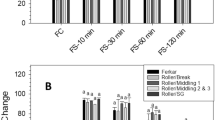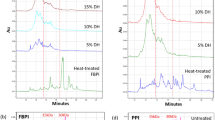Abstract
The overall goal of this research was to examine the effect of genotype and environment on the ratio of legumin to vicilin proteins (L/V), the surface characteristics and the functionality of air-classified faba bean protein concentrates. Seeds of five faba bean (Vicia faba) genotypes (CDC-Fatima, Taboar, SSNS-1, FB9-4 and FB18-20) grown in 2012 at two field plot locations, Melita and Morden (Manitoba, Canada), were used. L/V ratios ranged from 3.76 to 5.40 depending on the genotype and the environment, as only the effect of environment was found to be significant (p < 0.05). The L/V ratio for concentrates produced from seeds grown in Melita was greater than those grown in Morden. The effect of genotype and the interaction effect between genotype and environment on the surface charge were also found to be significant (p < 0.05). The protein concentrates’ surface charge ranged between −19.4 and −31.8 mV (at pH 7.0). The effect of environment on the interfacial tension was significant (p < 0.001), as the values for protein concentrates were found to be lower for those produced from seeds grown in Melita (7.9 mN/m) than those grown in Morden (10.2 mN/m). No significant effects were found for the surface tension and foaming capacity in response to either genotype or environment. The foam stability was influenced by the environment and by the interaction between genotype and environment (p < 0.05). The effects of genotype and environment on the emulsion stability, oil-holding capacity and water hydration capacity were insignificant. As for the protein concentrates’ solubility, the effect of genotype and the interaction between genotype and environment were significant, with values of solubility ranging between 82.3 and 88.0 %.

Similar content being viewed by others
References
Ofuya ZM, Akhidue V (2005) The role of pulses in human nutrition: a review. J Apply Sci Environ Manag 9:99–104
Makri EA, Papalamprou EM, Doxastakis GI (2005) Study of functional properties of seed storage proteins from indigenous European legume crops (lupin, pea, broad bean) in admixture with polysaccharides. Food Hydrocoll 19:583–594
Lampart-Szczapa E (2001) Legume and oilseed proteins. In: Sikorski ZE (ed) Chemical and functional properties of food proteins. Technomic Publishing Co., Lancaster, pp 407–436
Campbell LD, Olaboro G, Marquardt RR, Waddell D (1980) Use of faba beans in diets for laying hens. Can J Anim Sci 60:395–405
Davidson J (1980) Attempts to eliminate from field beans the anti-nutritive factor which reduces egg production. Br Poult Sci 21:299–307
Robblee AR, Clandini DR, Hardin RT, Milne GR, Darlington K (1977) Studies on the use of faba beans in rations for laying hens. Can J Anim Sci 57:421–425
Wang P, Ueberschar KH (1990) The estimation of vicine, convicine and condensed tannins in 22 varieties of faba beans (Vicia faba L.). Anim Feed Sci Technol 31:157–165
McMillan DC, Bolchoz LJC, Jollow J (2001) Favism: effect of divicine on rat erythrocyte sulfhydryl status, hexose monophosphate shunt activity, morphology, and membrane skeletal proteins. Toxicol Sci 62:353–359
Vioque J, Alaiz M, Giron-Calle J (2012) Nutritional and functional properties of Vicia faba protein isolates and related fractions. Food Chem 132:67–72
AOAC (2005) Official methods of analysis of AOAC international. Association of Official Analytical Chemists Inc, Gaithersburg
Laemmli UK (1970) Glycine-SDS-PAGE for separation of proteins. Nature 227:680–685
Bidlingmeyer B, Cohen S, Tarvin T, Frost B (1987) A new, rapid, high-sensitive analysis of amino acids in food type samples. J Assoc Off Anal Chem 70(2):241–247
Kato A, Nakai S (1980) Hydrophobicity determined by a fluorescence probe method and its correlation with surface properties of proteins. Biochim Biophys Acta 624(1):13–20
Liu S, Elmer C, Low NH, Nickerson MT (2010) Effect of pH on the functional behaviour of pea protein isolate-gum arabic complexes. Food Res Int 43:489–495
Chakraborty P (1986) Coconut protein isolate by ultrafiltration. In: Le Meguer M, Jelen P (eds) Food engineering and process applications. Elsevier Applied Science Publishers, New York, pp 308–315
Can Karaca A, Low N, Nickerson MT (2011) Emulsifying properties of chickpea, faba bean, lentil and pea proteins produced by isoelectric precipitation and salt extraction. Food Res Int 44:2742–2750
Boye J, Zare F, Pletch A (2010) Pulse proteins: processing, characterization, functional properties and applications in food and feed. Food Res Int 43:414–431
Acknowledgments
Financial support for this research was provided by the Saskatchewan Agriculture Development Fund (ADF 2012-0057), the Western Grains Research Foundation (WGRF CU-1303) and Saskatchewan Pulse Growers (SPCDB PRO 1304). All authors have no conflict of interests with any of the funding sources.
Author information
Authors and Affiliations
Corresponding author
Ethics declarations
Conflict of interest
None.
Compliance with ethics requirements
This article does not contain any studies with human or animal subjects.
Rights and permissions
About this article
Cite this article
Martinez, M., Stone, A.K., Yovchev, A.G. et al. Effect of genotype and environment on the surface characteristics and functionality of air-classified faba bean protein concentrates. Eur Food Res Technol 242, 1903–1911 (2016). https://doi.org/10.1007/s00217-016-2690-4
Received:
Accepted:
Published:
Issue Date:
DOI: https://doi.org/10.1007/s00217-016-2690-4




